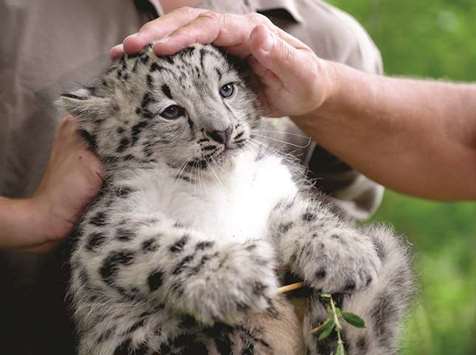Alcu isn’t bothered by the incessant clicking of the cameras. The snow leopard is basking in the sun, only a few metres away from a fence where some 40 reporters are gathered. When she’s had enough, she’ll limp away on her three legs back to her shelter.
Alcu has a stump where her front left leg used to be. She was rescued from a trap by gamekeepers in 2002, her leg severed by the mechanism’s iron teeth.
Since then, she’s been living in a 7,000-square-metre enclosure owned by the German Nature and Biodiversity Conservation Union (NABU) in the Issyk-Kul region of Kyrgyzstan.
Alcu has had a lot of visitors lately. Journalists from all over the world came to Kyrgyzstan for the International Snow Leopard and Ecosystem Forum, a global summit focused on how to protect and conserve the snow leopard. An excursion to her enclosure was one of the highlights of the programme.
The summit, which took place in Bishkek, the capital of Kyrgyzstan, attracted more than 250 scientists and conservationists, as well as representatives of the Asian countries whose mountains provide a natural habitat for the snow leopard, including Afghanistan, China, India, Nepal, Pakistan and Russia.
“We are all united by our desire to protect the snow leopard and increase its numbers,” said Kyrgyzstan President Almazbek Atambayev in an address.
But the snow leopard is more than an endangered species. This beautiful big cat has become a more general symbol for the threatened ecosystems of the Asian mountains.
“Today, it is no longer individuals who pose the largest threat to the snow leopard, but humanity as a whole,” says Matthias Feichter of the Snow Leopard Trust, a US NGO.
Poaching has fallen in the list of things threatening the snow leopard, replaced by the destruction of natural habitats through overgrazing, pollution, construction projects and, above all, climate change.
Mountain ranges such as the Himalayas, the Karakorum and the Pamir Mountains are especially sensitive to climate change, according to Ryan Bartlett, a climate expert for the World Wildlife Fund (WWF). Glaciers are shrinking, and rainfall patterns have become erratic.
“The very existence of humankind is in jeopardy,” Bartlett says. The prey of the snow leopard, wild mountain sheep, are themselves under threat because they are having to compete with cattle for grazing space in increasingly barren landscapes.
Bartlett believes the problem can only be solved in the long term if the whole world commits to the Paris climate agreement – from which the US recently withdrew.
In the short term, it’s about damage control by way of adapting to the changes and trying to find solutions.
One option could be so-called artificial glaciers – towers of ice built from melted glacial water which can be melted again to help solve water shortages.
The Global Snow Leopard and Ecosystem Protection Program (GSLEP) is also fighting to protect the habitat of the snow leopard, focusing on measures that include protecting against poaching, offering environmental education and preserving their prey.
In 2013, representatives from the project’s 12 member countries met in Bishkek to sign an agreement. They pledged to identify at least 20 healthy snow leopard populations around the world by 2020 and to make a commitment to protecting them.
The GSLEP project is being co-ordinated from a base in Bishkek, where Indian scientist Koustubh Sharma offers the following progress report: “We’re halfway there.”
Project workers have identified a total of 23 snow leopard habitats with a combined surface area of about 500,000 square kilometres – about the same size as Spain.
Conservation plans for the identified areas have already been set out by Kyrgyzstan, Pakistan, Mongolia, Bhutan and Nepal.
But money could prove to be a stumbling block.
Of the 182 million dollars pledged towards the project by the participating countries, only around a quarter has so far materialised.
The main funder is the Global Environment Facility, which provides funds towards environmental conservation projects in developing countries.
In a bid to increase momentum, conservation groups launched a “save the snow leopard” campaign and petition ahead of the summit in Bishkek, supported by Hollywood star Leonardo DiCaprio.
DiCaprio didn’t make it to the meeting, but he was represented by his Bollywood counterpart Dia Mirza.
As a goodwill ambassador for the campaign, it was she who officially handed the petition over to the government of Kyrgyzstan.
And to round off the conference, all participating countries confirmed their commitment to the Bishkek agreement. - DPA

The snow leopard is more than an endangered species. This beautiful big cat has become a more general symbol for the threatened ecosystems of the Asian mountains.

